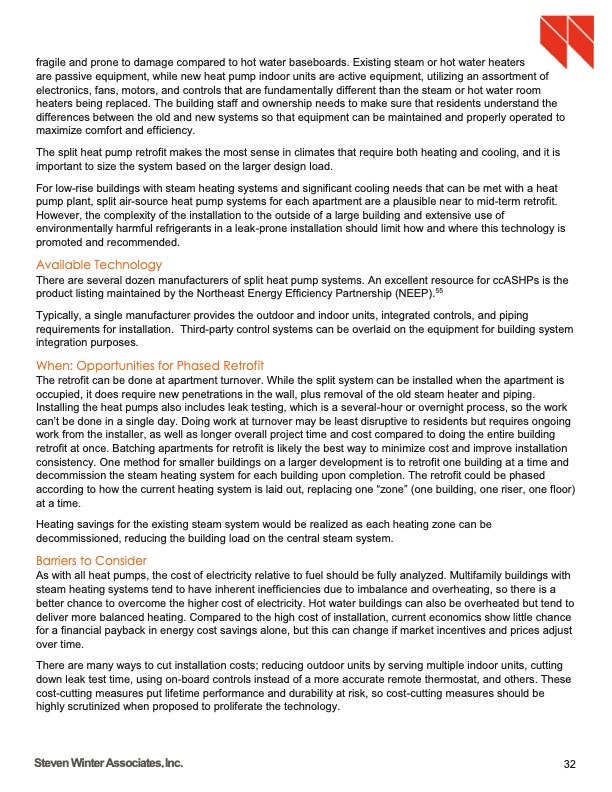
PDF Publication Title:
Text from PDF Page: 032
fragile and prone to damage compared to hot water baseboards. Existing steam or hot water heaters are passive equipment, while new heat pump indoor units are active equipment, utilizing an assortment of electronics, fans, motors, and controls that are fundamentally different than the steam or hot water room heaters being replaced. The building staff and ownership needs to make sure that residents understand the differences between the old and new systems so that equipment can be maintained and properly operated to maximize comfort and efficiency. The split heat pump retrofit makes the most sense in climates that require both heating and cooling, and it is important to size the system based on the larger design load. For low-rise buildings with steam heating systems and significant cooling needs that can be met with a heat pump plant, split air-source heat pump systems for each apartment are a plausible near to mid-term retrofit. However, the complexity of the installation to the outside of a large building and extensive use of environmentally harmful refrigerants in a leak-prone installation should limit how and where this technology is promoted and recommended. Available Technology There are several dozen manufacturers of split heat pump systems. An excellent resource for ccASHPs is the product listing maintained by the Northeast Energy Efficiency Partnership (NEEP).55 Typically, a single manufacturer provides the outdoor and indoor units, integrated controls, and piping requirements for installation. Third-party control systems can be overlaid on the equipment for building system integration purposes. When: Opportunities for Phased Retrofit The retrofit can be done at apartment turnover. While the split system can be installed when the apartment is occupied, it does require new penetrations in the wall, plus removal of the old steam heater and piping. Installing the heat pumps also includes leak testing, which is a several-hour or overnight process, so the work can’t be done in a single day. Doing work at turnover may be least disruptive to residents but requires ongoing work from the installer, as well as longer overall project time and cost compared to doing the entire building retrofit at once. Batching apartments for retrofit is likely the best way to minimize cost and improve installation consistency. One method for smaller buildings on a larger development is to retrofit one building at a time and decommission the steam heating system for each building upon completion. The retrofit could be phased according to how the current heating system is laid out, replacing one “zone” (one building, one riser, one floor) at a time. Heating savings for the existing steam system would be realized as each heating zone can be decommissioned, reducing the building load on the central steam system. Barriers to Consider As with all heat pumps, the cost of electricity relative to fuel should be fully analyzed. Multifamily buildings with steam heating systems tend to have inherent inefficiencies due to imbalance and overheating, so there is a better chance to overcome the higher cost of electricity. Hot water buildings can also be overheated but tend to deliver more balanced heating. Compared to the high cost of installation, current economics show little chance for a financial payback in energy cost savings alone, but this can change if market incentives and prices adjust over time. There are many ways to cut installation costs; reducing outdoor units by serving multiple indoor units, cutting down leak test time, using on-board controls instead of a more accurate remote thermostat, and others. These cost-cutting measures put lifetime performance and durability at risk, so cost-cutting measures should be highly scrutinized when proposed to proliferate the technology. Steven Winter Associates,Inc. 32PDF Image | HEAT PUMP RETROFIT STRATEGIES FOR MULTIFAMILY BUILDINGS

PDF Search Title:
HEAT PUMP RETROFIT STRATEGIES FOR MULTIFAMILY BUILDINGSOriginal File Name Searched:
heat-pump-retrofit-strategies-report-05082019.pdfDIY PDF Search: Google It | Yahoo | Bing
CO2 Organic Rankine Cycle Experimenter Platform The supercritical CO2 phase change system is both a heat pump and organic rankine cycle which can be used for those purposes and as a supercritical extractor for advanced subcritical and supercritical extraction technology. Uses include producing nanoparticles, precious metal CO2 extraction, lithium battery recycling, and other applications... More Info
Heat Pumps CO2 ORC Heat Pump System Platform More Info
| CONTACT TEL: 608-238-6001 Email: greg@infinityturbine.com | RSS | AMP |